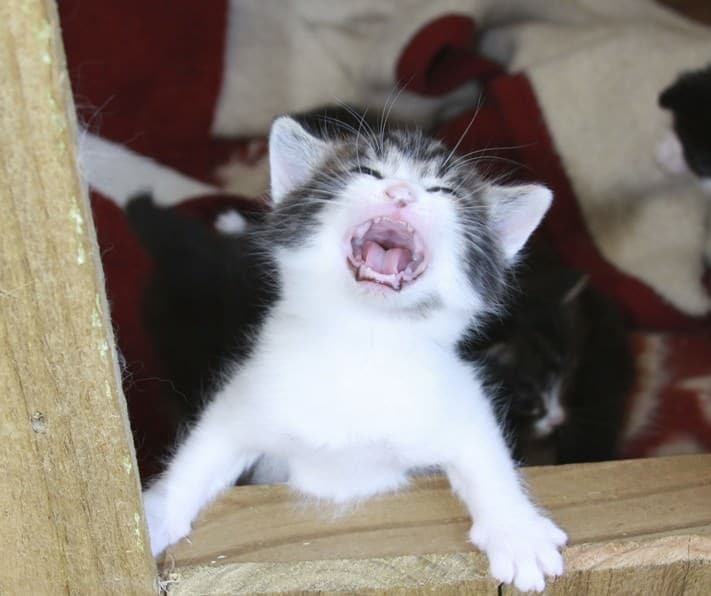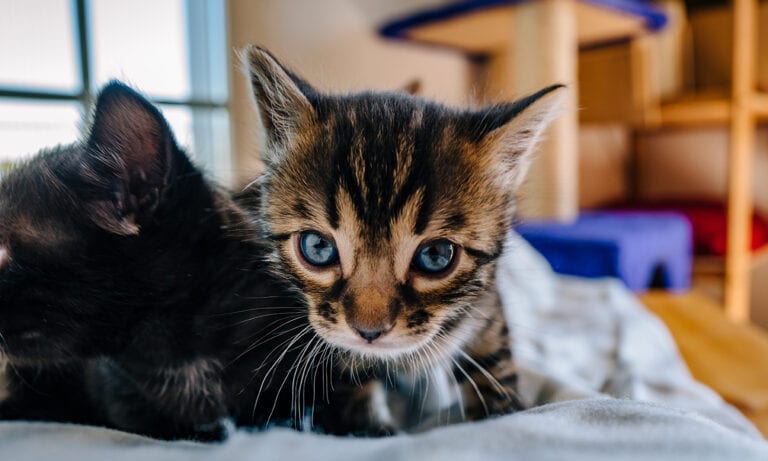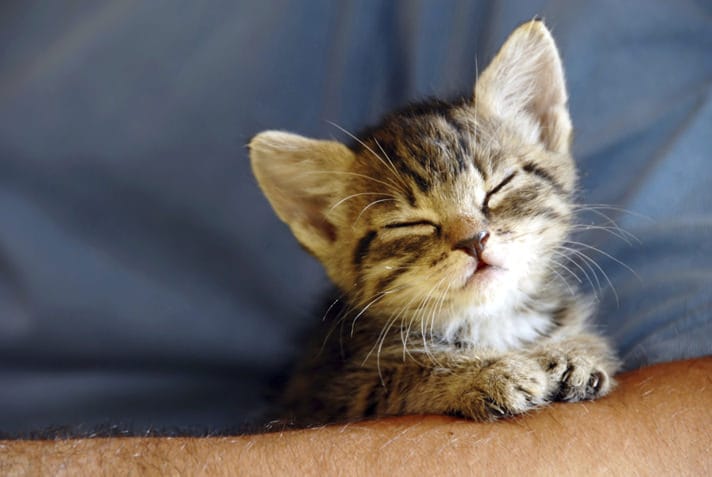Why did I decide to get a kitten?
This was the question running through my mind as I lay awake in bed at 3 a.m. the morning after I brought one home. Having recently lost one of my elderly cats, I had made the decision to adopt a new kitten. But on our first night together, I was being reminded of what that decision actually entailed. Being a wild cat trainer by trade and living adjacent to my very own zoo, I’ve raised a lot of kittens both wild and domestic, but my memories of kitten rambunctiousness had faded. Now, with this new addition, I was being abruptly reminded of the nocturnal nature, high energy and neediness that a kitten has to offer.
If you’re experiencing neediness issues with your kitten, don’t despair. Most problems can be easily lessened or solved completely through better understanding you kitten’s behavior and applying simple solutions to correct problems.
Needy Vs. Normal Kitten Behavior
A kitten, by definition, is going to need you. If you think about it, you’re the new parent and sibling rolled into one. Be prepared to devote a good amount of time helping her adjust to this new life and to attend to her needs.
A kitten’s behavior will be defined largely upon her prior experiences. If possible, before you bring your kitten home, gather as much information as you can about her past. This will help you understand her reasons for behaving or misbehaving. Don’t hesitate to ask questions.
A kitten who is acting unusual may just be acting out the stress she feels due to the sudden life changes. Imagine how she must feel in her new world, having been abruptly removed from her mother and siblings to face dramatic change in almost every way.
Some behaviors may seem odd, but are completely normal. For example, kittens and cats are crepuscular (active at dusk and dawn) and nocturnal, so you can expect frisky behavior when you’re ready to relax for the evening and drop off to sleep. You may also notice that your kitty is sleeping her life away. This is normal baby mammal behavior. Cats spend a lot of time sleeping as it is, but young and older individuals will snooze more often. Also, your kitty will need frequent feedings at first, so offer her food before she’s hungry enough to bother you for it.
It’s also important to note that some behavioral problems can be caused by health issues, so be sure to schedule your vet visit as soon as possible.
Training With Positive Reinforcement
So what should you do when your kitten is exhibiting demanding behavior? Although we most often think of dogs when we think of training, our feline companions are not only extremely trainable, but they can enjoy the training process. Young animals are perfect for the job, as they are very impressionable and eager for attention, so starting when your cat is a kitten is ideal. Let’s begin with three common demanding behaviors and simple techniques to start you on your way to becoming kitten trainer extraordinaire!
1. Meowing Out Of Turn
All of us at some point accidentally reinforce unwanted behavior. It’s extremely easy to do with a meowing kitten at your feet. She wants something; that’s obvious. Let’s try some cat food. Not hungry? How ‘bout a cat toy? That’s not it either. In the meantime she just keeps it up, and the meowing is getting louder and louder. You may not realize it, but by giving her everything she may need when she’s meowing, you’re teaching her to never stop. Why not teach her to meow on cue?
Tease her with a cat treat and when she meows say “Good” and give her the treat. Then, only offer treats, praise or petting for a meow when you have asked for the behavior. Never reward unsolicited meows.
2. Scratching Furniture
Sometimes cats seek attention by doing things that are destructive, such as scratching furniture. Kittens scratch to mark territory and to sharpen their claws. A cat scratching post may seem like an ideal solution, but sometimes the kitten will still prefer the furniture. That’s often because each kitty has her own personality, her own needs and preferences. If one scratching post doesn’t work, try a different type. There are many on the market. Then teach your kitty to use it.
My kitten, Zuma, preferred the slanted, pressed cardboard variety with catnip sprinkled through the cracks. When I saw her approach the furniture I would simply pick her up, sprinkle some catnip on the cardboard and place her on top. I would then scratch with my fingernails along with her as if I were the mother kitty, literally demonstrating what to do. I would also add a verbal cue and say, “Scratch, Zuma, scratch.”
It’s also important to run interference pre-furniture scratching. Catch her when she’s thinking about it instead of in the act. Then change her mind by helping to create and then reinforce the appropriate action. Be sure to praise her and pet her lightly while she’s on the scratching post. Even if she doesn’t scratch at first, she will eventually get the idea.
3. Kitten As Ankle Bracelet
Does your kitten follow you anywhere and everywhere around the house? Does she take it one step further and launch onto your calf with claws extended when stimulated by the movement of your stride? One simple solution to this painful kitten playfulness is a cat feather wand. These wands are flexible sticks with feathers attached at one end, and they work wonders. Not to mention, they are inexpensive and you can purchase them in any pet store.
Gather your wand and locate your kitty. Do not move until you have the kitty in sight or know what piece of furniture she’s hiding under. Now walk at your normal pace with the wand between your leg and the kitten. Wiggle the wand so the feathers by your feet will move and stimulate your kitten to play with the pretend bird instead of your leg. Make this a routine practice when passing by your kitty and she will quickly learn to attack the feathers instead of you. The feather wand can be handily used at any time to keep your pet busy and burn up excess energy.
Positive Or Negative?
Positive reinforcement in the form of treats and petting is the best method to use when training a kitten. However, sometimes, a little negative goes a long way. If you do use negative reinforcement, it is extremely important to immediately reward your subject the second she stops the unwanted behavior. For example, when your kitten meows out of turn, stomp your foot lightly. When the surprise noise stops the vocalization, quickly pet kitty and say, “Good girl.”
Whatever your kitten issues may be, there are training solutions to your problems. Once you learn the techniques and practice them consistently and often, you will be amazed at the positive results that follow for you and your special feline.
By: Mollie Hogan
Share:









